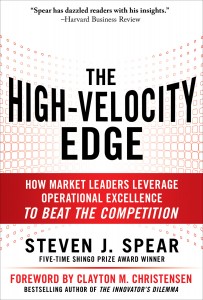How fast can your enterprise discover problems and solve them? The message in The High-Velocity Edge is very clear. Enterprises that outperform their competitors, often by wide margins, are learning organizations.
The book includes well researched case studies, including Steve Spear’s firsthand experiences on factory floors. Spear identifies and explains four capabilities high performing enterprises possess.
- System Design and Operation in a Manner that Reveals Problems and Weaknesses
- Problem Solving and Improvement at the Moment and in the Location Problems Occur
- Knowledge Sharing Throughout the Enterprise
- Developing High-Velocity Problem Solving Skills in Others Throughout the Enterprise
This fourth capability is particularly important as the other three capabilities can’t be fully leveraged without the participation of everybody in the enterprise workforce. This fourth capability may also be the hardest to develop as it challenges conventions most people have regarding authority in an enterprise. Spear’s observation in this regard is that the conventional management system is inverted in a learning and problem solving enterprise. Those close to the work are expected to see, learn and solve problems for themselves rather than be directed as to what to do by an authority. The senior manager is only called upon when the people close to the work determine they need help in addressing the problem. In this work structure the senior manager in a real sense becomes the most subordinate person, responding to the needs of the people responsible for providing value to a customer. That’s not a comfortable position for people that see senior management as a ticket toward prestige and privilege.
We’ve used this book successfully with a number of Study-Action Teams. The clarity of the case studies and ideas lend themselves to insights people can apply to their own enterprises and practical measures they can take toward improving the enterprise and the capability of the people throughout the enterprise. For service-oriented managers the book offers a path toward more effective leadership. While the insights in this book will be helpful to individuals, they will be even more useful and practical for teams of people who take the time to read and discuss the book together.

